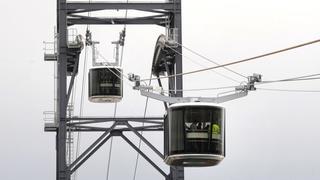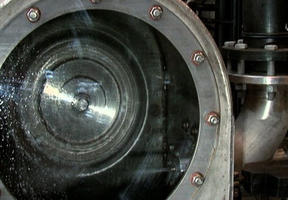Transportation: French Cities Opting for Cable Cars
10 min read
France's first urban cable car in the city of Brest opened in November 2016 and welcomed its millionth passenger on board on June 15, 2018, fulfilling its ridership objective. Several towns in the Paris area, as well as a number of cities elsewhere in France, now plan to install this new form of urban transportation, which is already used in major cities around the world.

© FRED TANNEAU / AFP - View of the Brest cable car's two cabins during its inaugural journey on November 19, 2016.
The cable car in Brest, Brittany links just two stops, located on either side of the Penfeld coastal river that flows through the port city. Its two cabins can each transport up to 60 passengers and take three minutes to cross the Penfeld, 72 meters above the water. Under normal operating conditions, departures are every five minutes, meaning that the system can transport 1,200 people every hour. While this capacity is still behind that of trams or underground trains, it is nevertheless sufficient to make the Brest cable car a means of public transportation in its own right, not simply a tourist attraction.
The advantage of cable cars, also known as cableways or aerial tramways, is that they can cross obstacles or climb slopes more easily than land-based systems. Urban centers in France considering installing cableways tend to be river cities, such as Bordeaux, Toulouse, Orléans and Rouen, where bridges quickly become congested. Paris is examining the possibility of linking up Gare de Lyon and Gare d'Austerlitz railway stations with a cable car crossing the river Seine. These systems can also be used to overcome other obstacles, such as highway junctions, railway lines and industrial hubs – a particularly attractive prospect for Parisian suburbs. In the Val-de-Marne area, for example, work on a cable car line between Créteil and Villeneuve-Saint-Georges is expected to begin in 2018.
Cities in hilly areas are also reaping the rewards of cable cars, including Rio de Janeiro, which has opened a network to provide transportation for communities in deprived favelaneighborhoods built on slopes1. The Brazilian metropolis is home to the world's first urban cableway, the Sugarloaf Cable Car, which opened in 1912. In Medellín, Colombia, the Metrocable system has played a key role in opening up the city to residents in working-class neighborhoods with previously poor access to public transportation. Bolivian capital La Paz, located in a canyon, has five cable car lines transporting 160,000 passengers per day.
Advantages and Disadvantages
- : With their electric motors, cableways are in the same category as trams and trolleybuses in terms of energy consumption and CO2 emissions. They use significantly less energy and emit much less CO2than buses running on . However, these figures are highly dependent on cabin capacity and passenger volumes, since the performance of a transit system is determined based on the number of people carried and kilometers traveled. The cabin Brest cable cars can carry 60 passengers and the Roosevelt Island line in New York 110, but other systems are often limited to ten or so people, meaning they would only be suitable for large-scale transportation if the departure frequency and number of lines were increased.
- Footprint and visibility: Cableways have a smaller footprint, and therefore take up less land, than tram lines. However, they are not always well received by residents, who are worried about being observed from above. This visibility issue is not insignificant: to tackle it, the Brest system is equipped with panes that become opaque as the cable cars pass over certain areas.
- Installation costs: Aside from specific difficulties in some areas, a kilometer of cableway costs about half as much to install as the same length of tramline. It also takes less time to build, since the routes between two stops are more direct. Noise pollution is generally low; however, the systems may not be able to run in strong winds or storms.
- Tourist attraction: Cable cars also often draw i make cities feel more modern. This is the case in London, for example, with the line crossing the river Thames, and the port of Yeosu in South Korea, where some of the cable cars have glass floors. In New York, the Roosevelt Island aerial tramway, which offers a scenic route over Manhattan, has remained in service even following the addition of a subway station. Amsterdam is considering installing a 1.5 kilometer line where passengers could admire the city's historic canals – albeit from a distance.



















